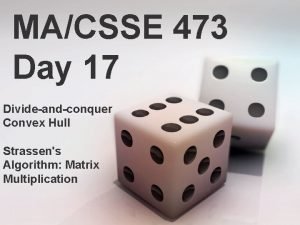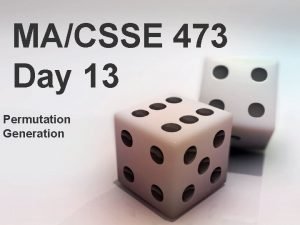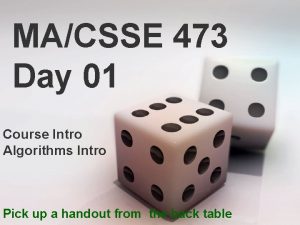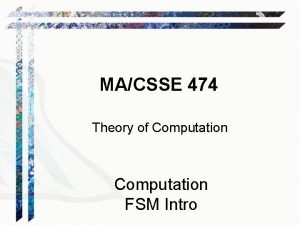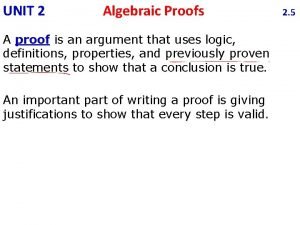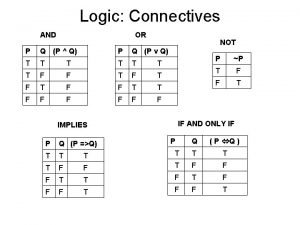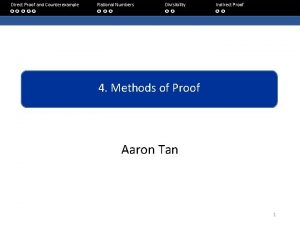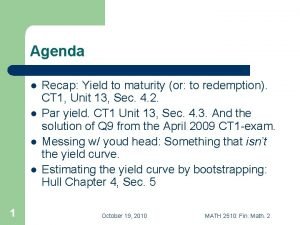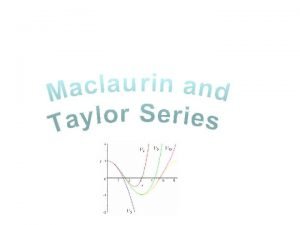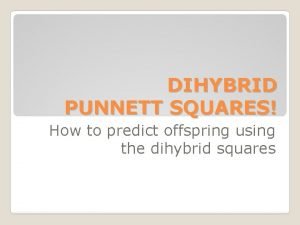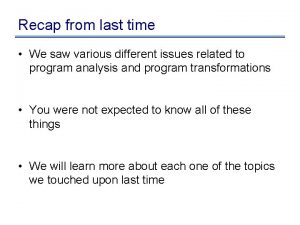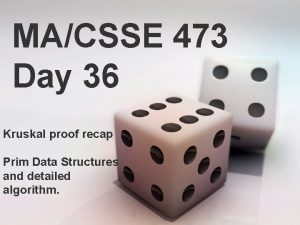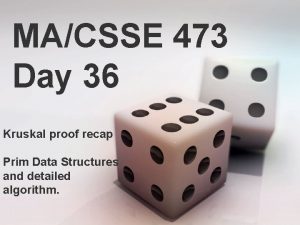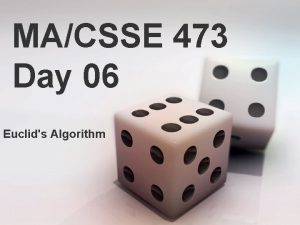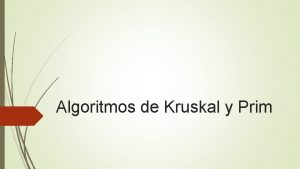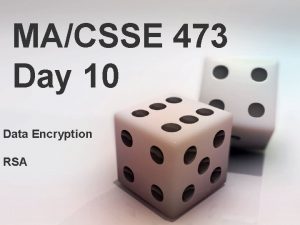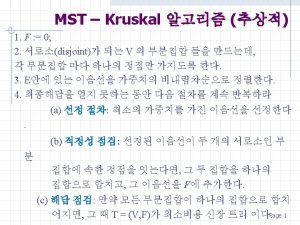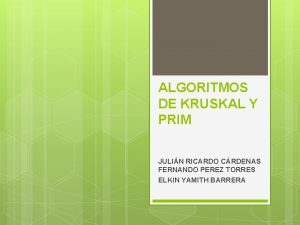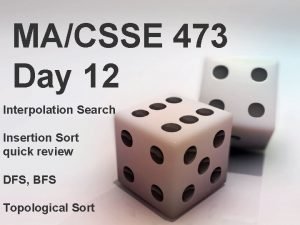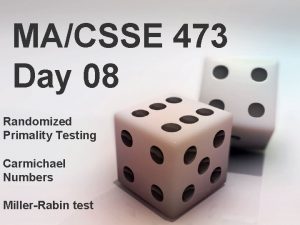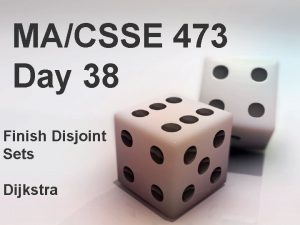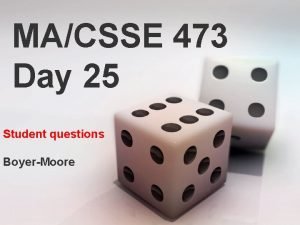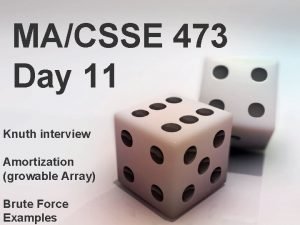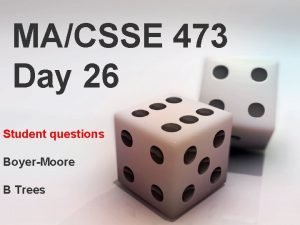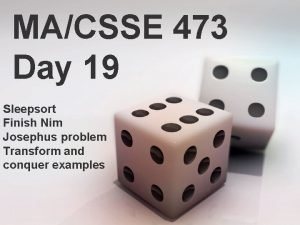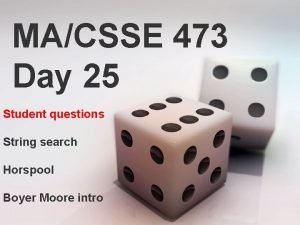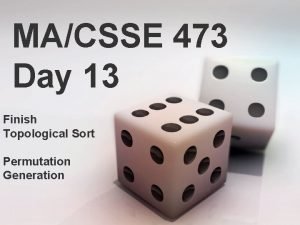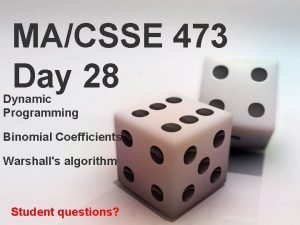MACSSE 473 Day 36 Kruskal proof recap Prim











![Indirect Min. Heap Representation Draw the tree diagram of the heap • • outof[i] Indirect Min. Heap Representation Draw the tree diagram of the heap • • outof[i]](https://slidetodoc.com/presentation_image_h2/cc9a7108979844b5388b457877cf8d4f/image-12.jpg)




















- Slides: 32

MA/CSSE 473 Day 36 Kruskal proof recap Prim Data Structures and detailed algorithm.

Recap: MST lemma Let G be a weighted connected graph with a MST T; let G′ be any subgraph of T, and let C be any connected component of G′. If we add to C an edge e=(v, w) that has minimumweight among all edges that have one vertex in C and the other vertex not in C, then G has an MST that contains the union of G′ and e. [WLOG v is the vertex of e that is in C, and w is not in C] Proof: We did it last time

Recall Kruskal’s algorithm • To find a MST: • Start with a graph containing all of G’s n vertices and none of its edges. • for i = 1 to n – 1: – Among all of G’s edges that can be added without creating a cycle, add one that has minimal weight. Does this algorithm produce an MST for G?

Does Kruskal produce a MST? • Claim: After every step of Kruskal’s algorithm, we have a set of edges that is part of an MST Work on the quiz questions • Base case … with one or two other students • Induction step: – Induction Assumption: before adding an edge we have a subgraph of an MST – We must show that after adding the next edge we have a subgraph of an MST – Suppose that the most recently added edge is e = (v, w). – Let C be the component (of the “before adding e” MST subgraph) that contains v • Note that there must be such a component and that it is unique. – Are all of the conditions of MST lemma met? – Thus the new graph is a subgraph of an MST of G

Does Prim produce an MST? • Proof similar to Kruskal. • It's done in the textbook

Recap: Prim’s Algorithm for Minimal Spanning Tree • Start with T as a single vertex of G (which is a MST for a single-node graph). • for i = 1 to n – 1: – Among all edges of G that connect a vertex in T to a vertex that is not yet in T, add to T a minimumweight edge. At each stage, T is a MST for a connected subgraph of G. A simple idea; but how to do it efficiently? Many ideas in my presentation are from Johnsonbaugh, Algorithms, 2004, Pearson/Prentice Hall

Main Data Structure for Prim • Start with adjacency-list representation of G • Let V be all of the vertices of G, and let VT the subset consisting of the vertices that we have placed in the tree so far • We need a way to keep track of "fringe vertices" – i. e. edges that have one vertex in VT and the other vertex in V – VT • Fringe vertices need to be ordered by edge weight – E. g. , in a priority queue • What is the most efficient way to implement a priority queue?

Prim detailed algorithm step 1 • Create an indirect minheap from the adjacencylist representation of G – Each heap entry contains a vertex and its weight – The vertices in the heap are those not yet in T – Weight associated with each vertex v is the minimum weight of an edge that connects v to some vertex in T – If there is no such edge, v's weight is infinite • Initially all vertices except start are in heap, have infinite weight – Vertices in the heap whose weights are not infinite are the fringe vertices – Fringe vertices are candidates to be the next vertex (with its associated edge) added to the tree

Prim detailed algorithm step 2 • Loop: – Delete min weight vertex w from heap, add it to T – We may then be able to decrease the weights associated with one or more vertices that are adjacent to w

Indirect minheap overview • We need an operation that a standard binary heap doesn't support: decrease(vertex, new. Weight) – Decreases the value associated with a heap element – We also want to quickly find an element in the heap • Instead of putting vertices and associated edge weights directly in the heap: – Put them in an array called key[] – Put references to these keys in the heap

Indirect Min Heap methods operation description run time init(key) build a Min. Heap from the array of keys Ѳ(n) del() delete and return the (location in key[ ] of the) minimum element Ѳ(log n) is. In(w) is vertex w currently in the heap? Ѳ(1) key. Val(w) The weight associated with vertex w Ѳ(1) (minimum weight of an edge from that vertex to some adjacent vertex that is in the tree). decrease(w, changes the weight associated with vertex w Ѳ(log n) new. Weight) to new. Weight (which must be smaller than w's current weight)
![Indirect Min Heap Representation Draw the tree diagram of the heap outofi Indirect Min. Heap Representation Draw the tree diagram of the heap • • outof[i]](https://slidetodoc.com/presentation_image_h2/cc9a7108979844b5388b457877cf8d4f/image-12.jpg)
Indirect Min. Heap Representation Draw the tree diagram of the heap • • outof[i] tells us which key is in location i in the heap into[j] tells us where in the heap key[j] resides into[outof[i]] = i, and outof[into[j]] = j. To swap the 15 and 63 (not that we'd want to do this): temp = outof[2] = outof[4] = temp = into[outof[2]] = into[outof[4]] = temp

Min. Heap class, part 1

Min. Heap class, part 2

Min. Heap class, part 3

Min. Heap class, part 4

Prim Algorithm

Adjacency. List. Graph class

Preview: Data Structures for Kruskal • A sorted list of edges (edge list, not adjacency list) • Disjoint subsets of vertices, representing the connected components at each stage. – Start with n subsets, each containing one vertex. – End with one subset containing all vertices. • Disjoint Set ADT has 3 operations: – makeset(i): creates a singleton set containing i. – findset(i): returns a "canonical" member of its subset. • I. e. , if i and j are elements of the same subset, findset(i) == findset(j) – union(i, j): merges the subsets containing i and j into a single subset. Q 37 -1

Example of operations • • • makeset (1) makeset (2) makeset (3) makeset (4) makeset (5) makeset (6) • • • union(4, 6) union (1, 3) union(4, 5) findset(2) findset(5) What are the sets after these operations?

Kruskal Algorithm What can we say about Sort edge list by weight (increasing order) efficiency of this algorithm for i = 1. . n: makeset(i) (in terms of |V| i, count, tree = 1, 0, [] and |E|)? Assume vertices are numbered 1. . . n (n = |V|) while count < n-1: if findset(edgelist[i]. v) != findset(edgelist[i]. w): tree += [edgelist[i]] count += 1 union(edgelist[i]. v, edgelist[i]. w) i += 1 return tree

Set Representation • Each disjoint set is a tree, with the "marked" element as its root • Efficient representation of the trees: – an array called parent – parent[i] contains the index of i’s parent. – If i is a root, parent[i]=i 5 2 8 1 4 7 3 6

Using this representation • makeset(i): • findset(i): • mergetrees(i, j): – assume that i and j are the marked elements from different sets. • union(i, j): – assume that i and j are elements from different sets

Analysis • Assume that we are going to do n makeset operations followed by m union/find operations • time for makeset? • worst case time for findset? • worst case time for union? • Worst case for all m union/find operations? • worst case for total? • What if m < n? • Write the formula to use min

Can we keep the trees from growing so fast? • • Make the shorter tree the child of the taller one What do we need to add to the representation? rewrite makeset, mergetrees findset & union are unchanged. • What can we say about the maximum height of a k-node tree? Q 37 -5

Theorem: max height of a k-node tree T produced by these algorithms is lg k • Base case… • Induction hypothesis… • Induction step: – Let T be a k-node tree – T is the union of two trees: T 1 with k 1 nodes and height h 1 T 2 with k 2 nodes and height h 2 – What can we say about the heights of these trees? – Case 1: h 1≠h 2. Height of T is – Case 2: h 1=h 2. WLOG Assume k 1≥k 2. Then k 2≤k/2. Height of tree is 1 + h 2 ≤ … Q 37 -5

Worst-case running time • Again, assume n makeset operations, followed by m union/find operations. • If m > n • If m < n

Speed it up a little more • Path compression: Whenever we do a findset operation, change the parent pointer of each node that we pass through on the way to the root so that it now points directly to the root. • Replace the height array by a rank array, since it now is only an upper bound for the height. • Look at makeset, findset, mergetrees (on next slides)

Makeset This algorithm represents the set {i} as a one-node tree and initializes its rank to 0. def makeset 3(i): parent[i] = i rank[i] = 0

Findset • This algorithm returns the root of the tree to which i belongs and makes every node on the path from i to the root (except the root itself) a child of the root. def findset(i): root = i while root != parent[root]: root = parent[root] j = parent[i] while j != root: parent[i] = root i = j j = parent[i] return root

Mergetrees This algorithm receives as input the roots of two distinct trees and combines them by making the root of the tree of smaller rank a child of the other root. If the trees have the same rank, we arbitrarily make the root of the first tree a child of the other root. def mergetrees(i, j) : if rank[i] < rank[j]: parent[i] = j elif rank[i] > rank[j]: parent[j] = i else: parent[i] = j rank[j] = rank[j] + 1

Analysis • It's complicated! • R. E. Tarjan proved (1975)*: – Let t = m + n – Worst case running time is Ѳ(t α(t, n)), where α is a function with an extremely slow growth rate. – Tarjan's α: – α(t, n) ≤ 4 for all n ≤ 1019728 • Thus the amortized time for each operation is essentially constant time. * According to Algorithms by R. Johnsonbaugh and M. Schaefer, 2004, Prentice-Hall, pages 160 -161
 Algoritma dijkstra matematika diskrit
Algoritma dijkstra matematika diskrit Prim
Prim Day 1 day 2 day 3 day 4
Day 1 day 2 day 3 day 4 Algebraic proof definition
Algebraic proof definition Macsse
Macsse Macsse
Macsse Macsse
Macsse Macsse
Macsse Day 1 day 2 day 817
Day 1 day 2 day 817 Direct proof and indirect proof
Direct proof and indirect proof Algebraic proof
Algebraic proof Direct proof and indirect proof
Direct proof and indirect proof Indirect proof
Indirect proof Direct proof and indirect proof
Direct proof and indirect proof Romeo and juliet act 1 summary
Romeo and juliet act 1 summary Ytm recap
Ytm recap Recap
Recap Bracket power rule
Bracket power rule Let's recap
Let's recap Briefly recap
Briefly recap Recap poster
Recap poster The crucible act 1 questions
The crucible act 1 questions Recap intensity clipping
Recap intensity clipping Recap accounting
Recap accounting X-axis
X-axis Black box recap
Black box recap Sample script for recapitulation
Sample script for recapitulation Gatsby chapter 8
Gatsby chapter 8 Foil method punnett square
Foil method punnett square Saw recap
Saw recap Summary of the shawshank redemption
Summary of the shawshank redemption What is an essay
What is an essay Pontius pilate allusion
Pontius pilate allusion




